|
The mid-to-late 1980s were a transformative time for the vampire sub-genre, for it was here, for better or worse, that the vampire movie as we know it today really started to take shape. The classical vampire of old had become the target of parody and was no longer seen as a convincing threat. This gave birth to what became an essential component of almost all modern genre films, the refusal of anyone in a position of authority to take the concept of vampires seriously, despite whatever evidence was laid at their door, usually by a teenager or an adult of shaky standing in the community. This allowed the vampires to operate with impunity, knowing that those with the power to potentially foil their plans would likely refuse to even acknowledge their existence, leaving potential victims with no-one to turn to when the fangs were bared. This development also acknowledged a similar cynicism on the part of an audience for whom vampires were the stuff of daffy old movies that they watched and laughed at on TV as a kid. Leading the pack, and beating the more frequently cited The Lost Boys to the post by a solid two years, was Child's Play director Tom Holland's 1985 debut feature, Fright Night, a film that effectively set the template for genre films to come, and did so with considerable style.
17-year-old horror buff Charley Brewster is making slow headway with his girlfriend Amy in his bedroom one evening when he spots two men carrying a coffin into the supposedly vacant house next door. The following day, he learns that he has new neighbours in the shape of Jerry Dandrige and his housemate, Billy Cole, and is given cause to challenge his divorced mother's speculation that they might be a gay couple when a strikingly attractive woman asks him for directions to their front door. The next day he learns that the woman has been murdered, and that evening is spying through his neighbour's window when he sees Jerry bare a pair of elongated incisors and make moves to bite the neck of another young woman. A short while later he spots Jerry and Billy carting what looks like her wrapped-up body to the trunk of their car. Charley is convinced that Jerry is a vampire, but his efforts to persuade Amy, his friend ‘Evil' Ed and even the police fall on deaf ears. When Jerry pops around and befriends his mother, however, Charley seeks the help of ageing TV horror movie host Peter Vincent, who has professed on his show that he believes in vampires. Vincent, however, proves to be as disbelieving as the others, but when Amy offers to pay him to go through the charade of meeting Jerry and disproving his vampire status to Charley, he quickly accepts. In the process of doing so, however, he discovers that Charley may be telling the truth after all.
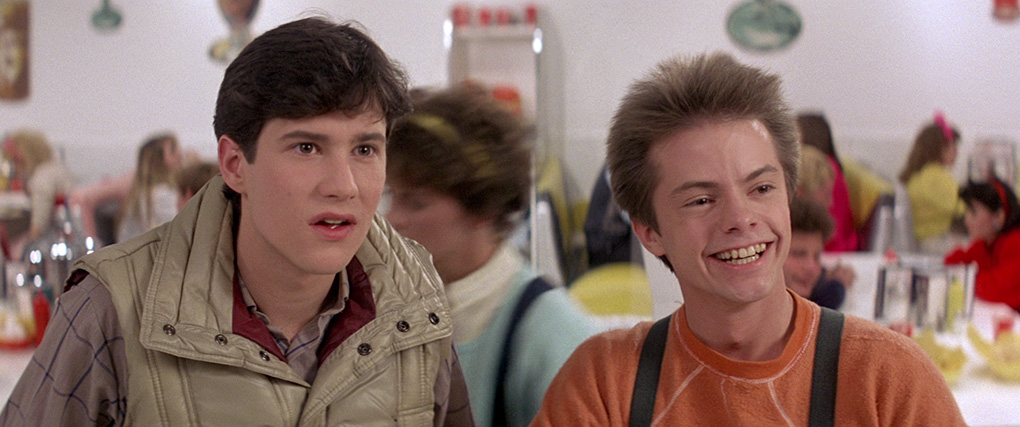
It's a lovely set-up that Holland as scriptwriter and director makes the most of from the opening scene, as what sounds like the prelude to a vampire attack turns out to be the soundtrack of an old horror movie starring and introduced by Peter Vincent on his ‘Fright Night' TV spot, which is playing in the background as Charley makes out with Amy in his bedroom. A few seconds later, Charley turns his back on Amy to allow her to undress and catches sight of Jerry and Billy carrying a coffin through their yard below. In the space of the unhurried first five minutes of screen time (which includes the opening credits), Holland has introduced and drawn a subtle thread between all five of the film's principal characters without making us feel he's done anything of the sort. Neat, huh?
As a long-standing fan of classic vampire movies, Holland acknowledges their codes and conventions and then plays creative games with them, having fun with the genre without ever mocking or ridiculing it. Thus, when Ed assures Charley that a vampire cannot enter your home unless invited, the brief boost this gives to Charley's self-confidence is quickly deflated when he finds that his lonely mother has invited their handsome new neighbour over for a drink. The first attempt to force Jerry to back off by thrusting a crucifix at him, meanwhile, falls flat on its face because without the required religious faith to back it up, both the action and the artefact are essentially meaningless. And belief proves to be a central motif of the film. Charley is unable to convince his friends of the validity of his claims because the concept of vampires is as hokey to them as it doubtless was to the movie-going public in the mid-1980s, something Holland smartly puts to his advantage. By cluing us in from the start to the authenticity of what Charley witnessed, Holland puts us in the position of understanding his friends' refusal to take him seriously even as we are increasingly frustrated by it. This isolates Charley as effectively as if he was trapped in an old dark house full of monsters on his own, unable to turn to anyone for help while his tormentor toys with him for his own amusement. In the process, Holland shakes off several years of mocking parody by making the vampire a figure of genuine menace again.
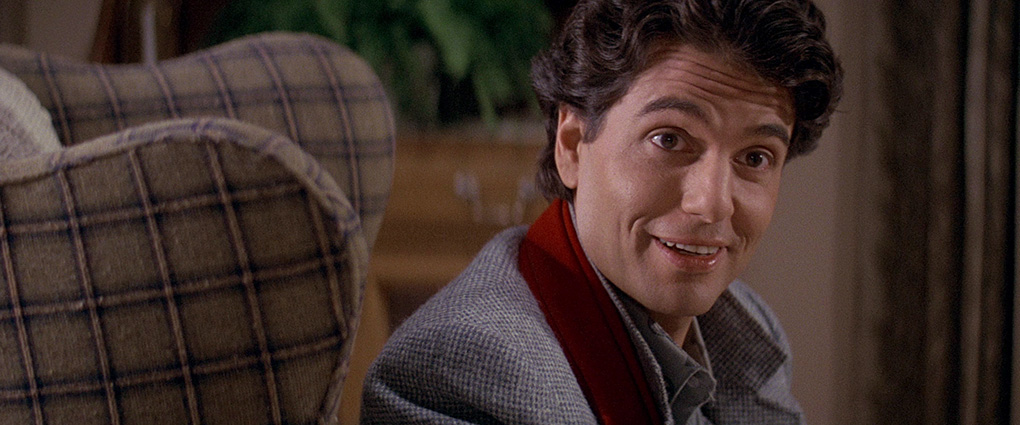
He's aided immeasurably by his skill for shaping character. Gone is the cape-wearing, Romanian-accented aristocrat of vampire lore to be replaced by a man who is handsome, charming and effortlessly debonair. It's easy to see why Charley's mother would want to get to know him better, or why Amy would later fall under his spell when the two dance at a nightclub, or even why a societal outsider like Ed would take Jerry's hand when he assures him that no-one will ever pick on or bully him again. As Jerry's loyal and (semi-) human manservant, meanwhile, Billy also kicks against the genre tradition of the helper as a sinister brute by cheerfully stoking the seeming absurdity of Charley's claims to visiting police detective Lennox. His amused cries of "Ooooo!" and comical crossing of his fingers into an improvised crucifix when Charley lets rip is not only funny in itself, it re-enforces Lennox's own incredulity at Charley's accusations and effectively shuts down this potential avenue of help. Here, as it would be in so many films from this point on, the vampire's greatest asset is our own disbelief in its existence and well-versed mockery of any claims to the contrary.
While the screenplay provides a rock-solid foundation, it's the sublimely chosen cast that make it sing at every turn. Chris Sarandon creates in Jerry one of the coolest vampires the screen has ever seen (piss on those pretty-boy Twilight teens), radiating self-confidence and seemingly amused at every move Charley and his motley crew try to make against him. His mockery of Peter Vincent's theatrical delivery of his signature "Welcome to Fright Night" line, which he follows by calmly crossing his arms and adding with a lovely hint of malicious intent, "...for real," is a delicious, pre-climactic scene highlight. As the loyal Bobby, Jonathan Stark is clearly having every bit as much fun as Jerry, and the two come across more as equal partners than master and servant, going about their ghoulish business with a skip and treating the resulting conflict as a rip-roaring game. As ageing horror star turned late night movie host Peter Vincent, the lovely Roddy McDowall proves sublime casting, perfectly pitching his ham TV presentations (watch the extra features for an example of how not to do it) and putting his signature wide-eyed look of fear to excellent use once he swallows his initial terror and decides to join the fray, only to find himself way out of his depth. William Ragsdale makes for a rounded and instantly likeable Charley, as does Amanda Bearse as Amy, at least when she stops giving her boyfriend huffily packaged grief for all but ignoring her every time she softens and offers herself to him (revelations about Jerry do all tend to hit Charley at inopportune moments). But stealing just about every scene he is in is Stephen Geoffreys as Evil Ed. Imagine, if you will, a young Denis Lavant raised on a diet of amphetamines and magic mushrooms, the result of which sees him find just about word that comes out of the mouths of his friends absurdly funny to the point of near hysteria. I'm sure this makes him sound like a nightmare creation whose every appearance risks bringing the film to its knees, but for me he's the film's most wildly delightful creation. His wide-eyed, open-mouthed amusement at almost everything Charley says or does is a joy in itself, and as a representation of that good friend that so many of us had in school whom we loved but whose don't-give-a-crap behaviour could drive us to distraction, Ed is almost without movie peer. And that's not all. As the extra features reveal, the actors brought more than strong performances to their roles. It turns out that it was Jonathan Stark's idea to transform Billy from a sinister manservant into one who would ridicule Charley's claims by just laughing them off, and Chris Sarandon who suggested that Jerry should often be seen eating apples, which was born of his own research into bats and has the effect of subliminally suggesting that this particular vampire is in tip-top physical condition and could probably give you a serious seeing-to even in human form.
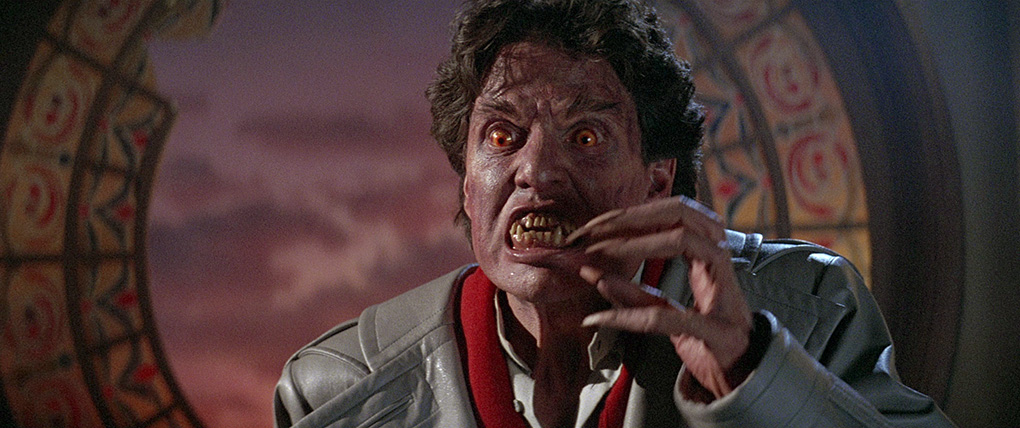
Where Fright Night did break new ground that was soon to be endlessly furrowed was in the nature and physical transformation of its vampire. Whereas previously this was largely limited to having the vampire open his or her mouth to reveal their fangs, occasionally accompanied by a set of blood-red contact lenses, here Jerry mutates from a handsome seducer into a ravenous humanoid gargoyle of the sort that would soon become the standard for film and TV blood-suckers. This combination of self-confident charmer and lethal monster allows Holland to reinvigorate the vampire as a convincing threat and build scenes of genuine tension, isolating Charley through the disbelief of others and effectively giving Jerry the keys to his house to visit and potentially destroy him any time that he pleases. The makeup effects and a late-film, on-screen transformation sequence are also impressive, taking their cue from the new generation of werewolf movies spearheaded by The Howling and An American Werewolf in London and every bit their equal, the result of the dtermination of a young effects crew to top the work of their mentors Rick Baker and Rob Bottin.
I remember enjoying Fright Night when I first saw it on its UK cinema release, but did wonder how it would play now after all these years and all the vampire movies and TV series that followed in its wake. Would it, like so many of its 80s mainstream brethren, feel a little stuck in the decade in which it was made? It is with no small degree of delight that I can confirm that the answer to that question is an emphatic "No!" Over 30 years after it first hit cinema screens, Fright Night stands as a shining example of the modern and even post-modern vampire tale at its hugely enjoyable best. Its blend of drama and humour is impeccably done and a testament to horror fan Tom Holland's determination to have fun with the genre rather than make fun of it, the script is smart, witty and genre-savvy. The performances are a joy, the practical makeup effects first class, and the direction so energetically confident that it makes an absolute mockery of the fact that this was Holland's directorial debut. The film's subsequent cult status is both deserved and in retrospect unsurprising, and for my money it still wipes the floor with pretty much all of its subsequent mainstream competition.
The Blu-ray in this dual format set sports an absolutely gorgeous 2.40:1 transfer from a 4K restoration, I'm presuming from the original negative (the disc and the booklet give us no clue here). Just about everything is close to reference quality – the contrast is sublimely pitched, with crisp blacks but very good shadow detail, the largely naturalistic colour palette is most attractively rendered, and the sharpness and level of picture detail up there with quality transfers of high-budget modern mainstream features. There's not a mark or a dust spot anywhere and a fine level of film grain is visible but in no way intrusive. Superb.
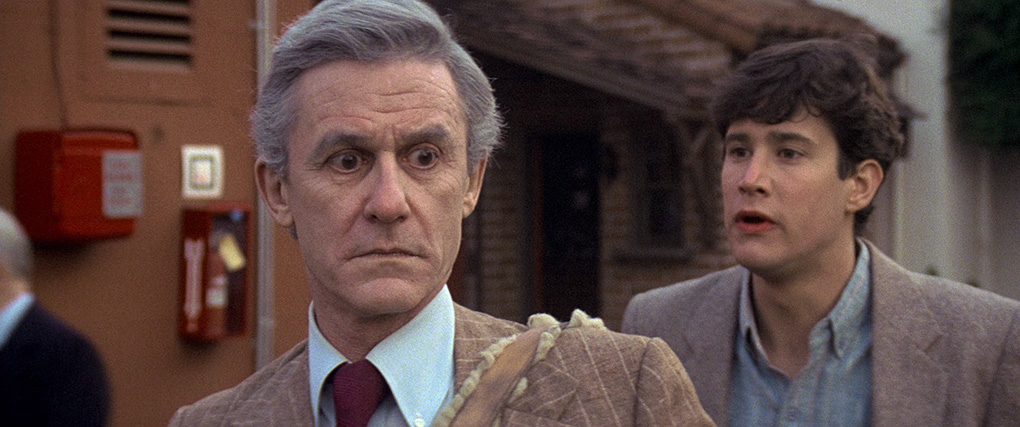
For the soundtrack, you can choose between Linear PCM stereo and DTS-HD Master Audio 5.1 surround. There's not much to choose between them in terms of audio quality, which is clear and lively on both, though the dialogue is confined to the centre speaker on the surround track and is spread across the front speakers on the stereo. The dialogue sits exclusively at the front on the surround track, though music and some of the sound effects make use of the rear speakers.
Optional subtitles for the deaf and hearing impaired are available.
Fear Fest 2008 Reunion Panel (54:32)
An audience Q&A with some of the key players from Fright Night and its immediate sequel, recorded at Fear Fest 2008. Those in attendance are Tom Holland, Chris Sarandon, William Ragsdale, Jonathan Stark, Amanda Bearse and Stephen Geoffreys from Fright Night, and director Tommy Lee Wallace and actress Julie Carmen from Fright Night Part 2. How much you'll get from this depends in part on whether you watch it before or after the documentary detailed below, as a fair amount of the content from here is repeated there, but there's still plenty worth hearing and a couple of anecdotes unique to this feature, one involving boxer Sugar Ray Leonard. Intriguingly, one fan asks when we're likely to see a special edition disc release. Well, guess what? Note that this was not filmed by a professional crew, so the camerawork is sometimes a little twitchy and the sound was recorded with what was likely an on-camera mic, which sometimes hinders clarity and the audience questions are often impossible to make out.
Choice Cuts with Tom Holland and Ryan Turek (28:18)
A three-part interview with writer-director Holland, conducted by genre writer and aficionado Ryan Turek for Choice Cuts, which I'm guessing is a webcast show. Conducted at Holland's house, if finds the filmmaker in upbeat and engagingly chatty mood, as he talks about his script work, the process of writing Psycho II, developing the screenplay for Fright Night, how his early work as an actor informed his direction, and more. A nice inclusion.
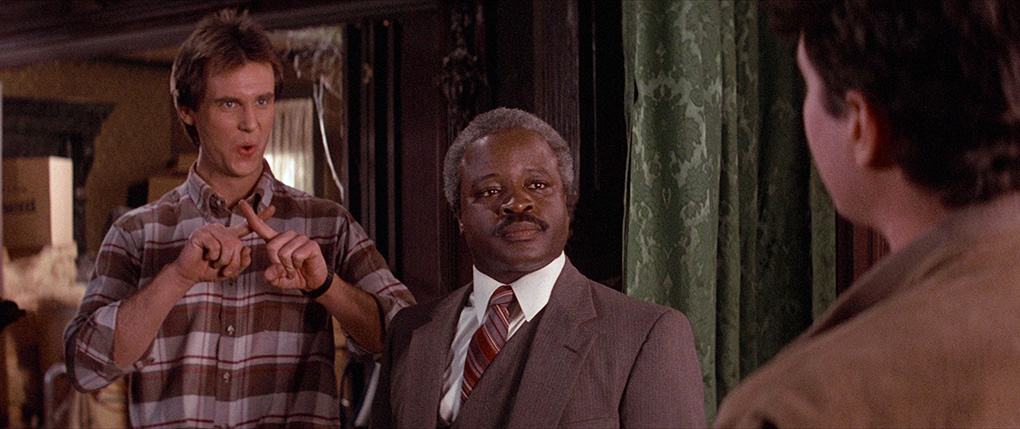
Vintage Electronic Press Kit (1:33:59)
Presented in standard definition and with a few short but very visible glitches and wearing a timecode counter prominently throughout, this press kit is a collection of material produced for use by others in promoting the film. Included is: a scroll of text quotes; a music video for the bloody J Geils Band song that runs over the closing credits (I'm not a fan), plus a piece on its making; two versions of a featurette on the making of film (one with and one without a Roddy McDowall intro); four brief ‘newswraps' on the director and cast members; two versions of an interview with special effects coordinator Richard Edlund (one short, one longer); unedited versions of the interviews with cast and crew members used throughout and some clips from the film, presumably for programme editors to assemble their own featurettes (I'd certainly find such material useful). Despite the iffy quality, a valuable grab – the featurette and interviews are of particular interest, despite the cheesy voice-over on the former.
Theatrical Trailers (2:49)
Two versions of the studio trailer that deceptively markets the film as a straight-up horror movie and completely ignores its wit and humour, something that annoyed the filmmakers no end.
Stills and Memorabilia Gallery (64 pics)
Exactly what the title above suggests, 64 high-resolution slides of production and behind-the-scenes photos, official documentation, creature models and poster artwork.
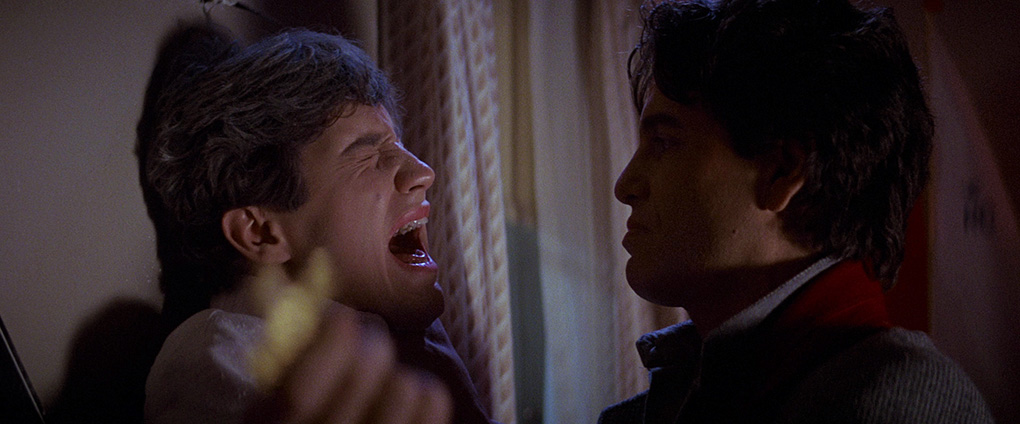
You're So Cool, Brewster! (2:26:42)
Take a look at that running time. Yep, this retrospective documentary on the making of the film runs for considerably longer than the main feature and is absolutely loaded with useful interviews with the cast and crew. As expected, the first third is focussed on how the film came to be, the process of selecting the cast, and some of the specifics of the production itself. There are plenty of engaging anecdotes, a whole section on Roddy McDowall, and an absolute ton of material on the creation of the makeup effects – seriously, this must occupy almost half the running time. If you find this at all interesting then you're in for a treat, as the detail the effects crew go into is often fascinating – I learned a hell of a lot from this section. There's also discussion on the music, the promotion (the studio created trailer mis-sold the film as a hard-core horror), its success and subsequent cult following and the sequel, Fright Night Part 2. My only gripe is the decision to have someone present the whole thing as Peter Vincent in bad actor mode, which really does help demonstrate what made Roddy McDowall such a bloody good actor – when Roddy does ham presentation in the film it's funny, when this guy does it you want to crawl under you chair and pray he quickly goes away. The programme, like a few other extras here, was produced by a company called Dead Mouse Productions, so they can take the blame, but also deserve serious credit for the rest. Presenter aside, a wonderful and satisfyingly complete documentary.
What is Fright Night? (10:42)
Comprised largely of interview footage not used in the above documentary, here the actors and crew share their views on Tom Holland both as a writer and director, obviously with specific reference to Fright Night. Music plays in the background throughout and at one point comes close to drowning actress Julie Carmen out. Holland himself is most eloquent on the metaphorical aspect of horror, and its ability to reflect what is happening in society more effectively than mainstream genres. Absolutely.
Tom Holland: Writing Horror (8:55)
Another Dead Mouse Production compiled with unused interview material from the documentary, underscored with the same music and with a similarly excitable, in-out-and-across use of the Ken Burns effect on still images. This one focuses on the process of writing Fright Night, the thinking behind it, and what drew the actors to it. In a clearly heartfelt plea, Holland advises and up-and-coming filmmakers (or musicians, as it happens) to try and retain creative control over whatever you do.
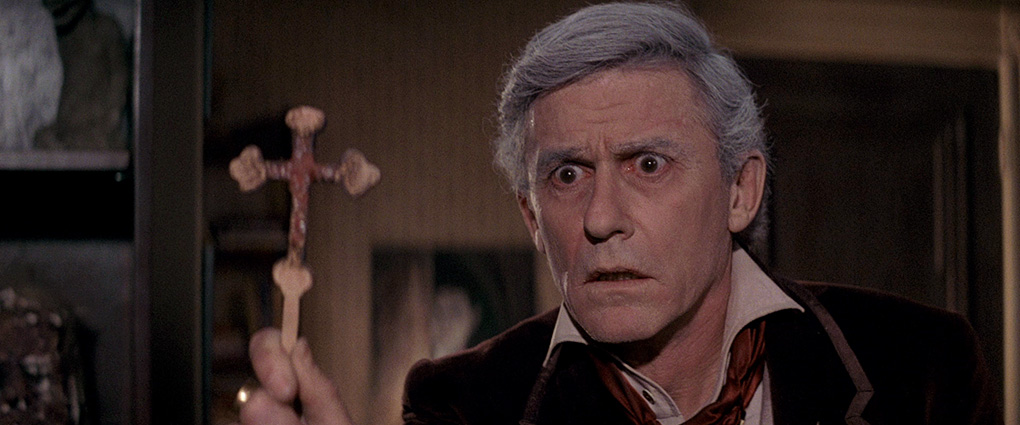
Roddy McDowall: From Apes to Bats (20:53)
More Dead Mouse interview footage, this time focusing on Roddy McDowall, whose long film career and warm personality and is engagingly outlined here. There are anecdotes aplenty from the shoot and beyond – composer Brad Fiedel remembers McDowall being in drag when he first met him (it was for a film), Tom Holland recalls being taken by him to visit tunnels that ran beneath the MGM studio buildings, Chris Sarandon recalls that every year on his birthday he'd get a postcard from McDowall, wherever in the world he was working, and actor Bob Corf recalls being invited to visit him on the set of Planet of the Apes and then spending some time trying to find him as he and many others were wearing their ape makeup. Once again, the (same) background music comes close to drowning out the soft-spoken and quietly mixed Julie Carmen, but otherwise is OK.
Also included is the expected Eureka Booklet, whose primary content is an excellent essay on the film and its place in the genre's development by Craig Ian Mann. Notes on viewing, credits for the film and a number of stills are also included.
Looking back from a modern perspective, it seems clear that Fright Night was the vampire film that us long-standing horror fans had been waiting for, one that drew on the classic genre movies of years past and successfully brought the vampire into the modern age, in a manner that others had tried but failed to convincingly do. It infuses its horror with humour and allows each to inform and enhance the other, has one of the coolest and most casually threatening vampires in modern genre cinema, and builds to an absolute belter of a finale. The transfer on the Blu-ray is superb, and you couldn't ask for a more complete and comprehensive collection of extra features. At present, this is only available as a limited edition, dual format Steelbook through Zavvi, and as far as I'm aware they've already sold every copy they have. This means that you'll have to wait until the regular dual format release arrives in April, which makes this review seem like a bit of a spiteful tease. But it really is worth the wait. Highly recommended.
|